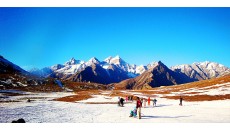
Moon Land Leh
- Location
- India
- Places to Visit
- Share
By signing up, I agree to Travelo's Terms of Service, Privacy Policy, Guest Refund olicy, and Host Guarantee Terms.
Already a Travelo member? Login
Don't have an account? Sign up
Leh-Few places in India are at once so traveller-friendly and yet so enchanting and hassle-free as mountain-framed Leh. Dotted with stupas and crumbling mudbrick houses, the Old Town is dominated by a dagger of steep rocky ridge topped by an imposing Tibetan-style palace and fort. Beneath, the bustling bazaar area is draped in a thick veneer of tour agencies, souvenir shops and tandoori-pizza restaurants, but a web of lanes quickly fans out into a green suburban patchwork of irrigated barley fields. Here, gushing streams and narrow footpaths link traditionally styled Ladakhi homes and hotels that feature flat roofs, sturdy walls and ornate wooden window frames. Leh’s a place that’s all too easy to fall in love with – but take things very easy on arrival as the altitude requires a few days' acclimatisation before you can safely start enjoying the area's gamut of adventure activities.
Ladak-Spectacularly jagged, arid mountains enfold this magical Buddhist ex-kingdom. Picture-perfect gompas (Tibetan Buddhist monasteries) dramatically crown rocky outcrops amid whitewashed stupas and mani walls. Colourful fluttering prayer flags share their spiritual messages metaphorically with the mountain breeze. Prayer wheels spun clockwise release more merit-making mantras. Gompa interiors are colourfully awash with the murals and statuary of countless bodhisattvas.Though threatened by a rapidly increasing number of visitors, Ladakh has much to teach the West regarding ecological awareness. The walls of dramatic mountains that hem in Ladakh make for an unforgettable landscape, but be aware that road access requires crossing tortuous high passes, which close from around October to May (or longer when snows are heavy).
Nubra-The deep-cut Shayok and Nubra River Valleys offer tremendous scenery on a grand scale, with green oasis villages surrounded by thrillingly stark scree slopes, boulder fields and harsh arid mountains. There are sand dunes, monasteries, a ruined palace and – at Turtuk and Bogdang – a whole different culture (Balti) to discover. Permits are required by foreigners.
Turtuk-The turbulent Shayok valley between Hunder and Turtuk is 80km of scenic magnificence marred only very occasionally by military installations. The grand raw-rock valley briefly narrows near tiny Changmar, the western limit of Ladakhi-Buddhist culture. Thereafter, the rare green splashes of village are culturally and linguistically Muslim Balti. The main centres of Turtuk and less-visited Bogdang villages are raised patchworks of fields and houses on terrace ledges above the main road. Summer sees locals carting huge bundles of barley straw on their backs between the apricot trees. Upper Turtuk has unforgettable views towards serrated high peaks in Pakistan: the frontline is only 7km away. Indeed Turtuk itself was part of Pakistan until the 1971 war.
Note that while many travellers find Turtuk a Ladakh highlight, some others consider its quiet simplicity doesn't quite justify the long journey.
Pangong-Stretching around 150km (with the eastern two-thirds in China), this mesmerising lake plays artist with a surreal palette of vivid blues, which contrasts magically with the surrounding colourful mineral swirls of starkly arid, snow-brushed mountains. The scene is also striking for the almost total lack of habitation along shores whose turquoise waters can look Caribbean. Visitor activities don't stretch much beyond ogling the ever-changing lake, but one 'sight' is a sand spit nicknamed ‘Shooting Point’ since its use as a filmset for the 2009 Bollywood hit The 3 Idiots.A Leh–Pangong jeep safari is a joy in itself, scenically magnificent and constantly varied with serrated peaks, trickling streams, horse meadows, reflective ponds, drifting sands and a 5369m pass. But it's a long drive, so do plan on sleeping at least one night. Foreigners require permits and may not loop to Tso Moriri via Loma Bend (Indians with Chushul permits may do so).